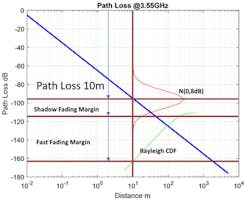Latest from Home
Hostile Propagation Impairments Explained
Wireless transmission all begins with an electromagnetic (EM) wave that is coupled from wires to air using an antenna. In its trajectory from the transmitter to the receiver (where the inverse process occurs, namely, the EM wave is coupled from air to wires by another antenna), a lot of effects happen, like path loss (where power density decreases vs. increasing distance), shadow fading (where large obstacles cause random power variations), echoes (better known as multipath caused by reflections, diffractions, and refractions), Doppler shifts (due to movement), depolarization, angular dispersion (also known as angular spread), and correlation (when more than one antenna is used in the transmitter and/or receiver, also known as Multiple Input Multiple Output or MIMO).
All these effects are collectively known as propagation impairments. The impairments created by the propagation environment are very hostile to EM waves. For years, the most brilliant minds in the field of telecommunications (encompassing semiconductors, analog and digital circuits, antennas, information theory, etc.) have dedicated their lives to understand and deal with the aforementioned impairments.
As of the latest generation of cellular networks (5G NR), and early research in 6G, air interfaces have adapted to live with and make use of those propagation impairments. Regardless of the Radio Access Network (RAN) architecture being aggregated (closed or proprietary) or disaggregated (as in Open RAN), propagation impairments need to be properly characterized, simulated, and emulated to validate the techniques employed as counter measures to mitigate the hostile environment.
Two Types of Fading
Propagation impairments can be divided into slow fading and fast fading.
- Slow fading impairments, like shadow fading or path loss, cause gradual fluctuations of received power over relatively long periods of time, whereas fast fading produces large swings in received power at timescales comparable to the signaling rates. Those large swings are caused by the incoherent addition of a continuum of signal replicas (i.e., multi-path) shifted at random Doppler frequencies due to movement.
- The fast fading category requires the most ingenious techniques (such as time/frequency/space diversity, equalization, power control, Orthogonal Frequency Division Multiplexing, MIMO, and Massive MIMO), as the effects need to be compensated by the receiver as fast as it can to maximize the probability of successful information reception.
As an example, consider an urban environment with a propagation exponent of 3 (for reference, in free space the propagation exponent is 2 and is defined by the Friis Propagation Formula. Path loss is a function of frequency, separation between transmitter and receiver, and propagation exponent) at the popular C band (3.55GHz), a shadow fading characterized by a Gaussian distribution with zero mean and standard deviation σ of 8dB. (The standard deviation for shadow fading depends on the environment. Typically, 8dB is used to represent urban propagation and a Non-Line of Sight (NLOS) scenario characterized by a Rayleigh distribution with unit power.
Figure 1 represents a graphic depiction of the procedure to calculate the link budget with a given reliability that considers the main three impairments: path loss, shadow fading, and fast fading. The instantaneous received power is simply the addition (in dB) of the three effects. It is worth noting that in addition to the Friis formula, empirical methods based on measurements to determine path loss have been used for years. For example, Hata, Okumura, Walfisch, and Bertoni.
A different way to characterize fast fading is by its rate of change. Fading rate is very important, as the receiver must perform channel estimation to determine coherent detection maximizing capacity. The information needed is contained in its Doppler spectrum. For narrowband fading, the classical “U” shape is a very good characterization of the only resolvable path, resulting in a flat frequency response (i.e., flat fading). For wideband systems, resolvable multipath components are present, and this causes frequency selectivity (i.e., frequency selective fading, where different parts of the spectrum see different amplitude, group delay, and phase responses) and its counterpart delay spread, where each tap has traditionally been considered to have a Laplacian Power Angular Spectrum (PAS, an indication of the concentration of power in a given 2D or 3D angular direction) yielding a non-classical Doppler spectrum that depends on the individual path (or cluster) angle of arrival (AoA in azimuth, ZoA in elevation).
More Data Means More Complexity
As mentioned before, the seemingly endless appetite for more data lead to the exploitation of the spatial domain using MIMO techniques. Spatial multiplexing allows to increase the links spectral efficiency by the minimum of the number of antennas at the transmitter (N) and at the receiver (M). For example, a transmitter with two antennas and a receiver with two antennas (simply abbreviated 2x2) are capable of two spatial streams. This is very attractive since spectrum is one of the costliest commodities in wireless communications. However, for the spatial streams to be successfully decoded, the instantaneous fast fading channel composed of MxN complex gains (organized in a matrix of that size) must show a great degree of linear independence.
For Rayleigh fading, the underlying components are complex Gaussian random variables, and independence also means uncorrelatedness. For real propagation channels, this is seldom the case, as limited spatial separation and limited angular spread cause antenna correlations greater than zero. In the limit, for channels with zero scattering, for example Line-of-Sight (LOS), the channel matrix has only one linearly independent row or column, and spatial multiplexing fails.
To get around this problem, antennas with orthogonal polarization (typically, vertical/horizontal or dual slant ±45°) are introduced. But this limits the spatial streams to two (as a side note, early 6G studies suggest the possibility of using orbital angular momentum to create orthogonal wavefronts). An interesting proposal to go around the problem of limited scattering makes use of a Reconfigurable Intelligent Surface (RIS) that can intelligently reflect EM waves. The idea is to use RIS to create a reflection with the right angle/phase to improve the chances of successful reception.
In 5G, the concept of using antenna arrays with a large number of elements (Massive MIMO), and in 6G with an even larger number of antennas (Ultra Massive MIMO), was introduced to control interference. With so many antennas organized in planar arrays, very narrow beams in 3D can be formed, concentrating the EM waves on specific spatial points, thus reducing interference. However, all the benefits come at a price of added complexity to keep the phases aligned at the array, and to keep the channel reciprocity (over the air) despite using different electronic circuits for downlink and uplink.
All the impairments suffered by the traveling EM waves from the transmitter to receiver described above need to be carefully characterized, and accurate models must be obtained to properly assess the performance of each mitigation technique. This is true for any kind of Radio Access Technology (RAT), and any implementation of the RAN (either closed or open).
It Matters
Focusing on Open RAN implementations, accurate propagation modeling is seen as crucial since network operation/maintenance/optimization can be performed by anyone. Specifically, if a given company wants to create applications for the RAN Intelligent Controller (RIC), those applications must be tested with accurate propagation models to validate algorithms.
Those algorithms control the RAN settings of each technique devised to mitigate the impact of the impairments described here. Examples are the HARQ processes, handover timers/thresholds, scheduling over time/frequency resources, AMC thresholds, power control steps, beam switching, RIS reflection angle, power, delay, and phase, and a long list of other optimization parameters. This holds true for each and every component in Open RAN architecture. For more information specific to comprehensively testing Open RAN, download our eBook.
Alfonso Rodriguez Herrera | Senior Staff Architect, Spirent Communications
Alfonso Rodriguez Herrera is a Senior Staff Architect with Spirent Communications. He has more than 20 years of experience in wireless communications and standards (3GPP/3GPP2, IEEE, ISO). The content was adapted from www.spirent.com.
For more information, visit: www.spirent.com/blogs/what-is-fading-and-why-is-it-important-for-o-ran-testing. You can also follow us on Twitter: https://twitter.com/Spirent, LinkedIn: https://www.linkedin.com/company/spirent-communications/, and Facebook: https://www.facebook.com/spirent.





